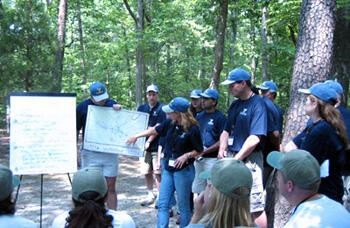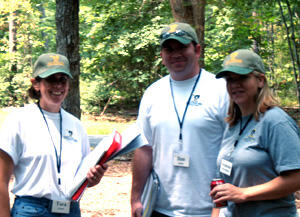Sept. 7, 2006
Battle of Chancellorsville
Share this story

Military metaphors frequently infiltrate discussions of business strategy, but rarely are the parallels between the battlefield and the boardroom as explicitly drawn as in VCU’s School of Business Fast Track Executive MBA class.
Each year, the class visits the site of the Civil War’s Battle of Chancellorsville to explore issues of leadership on the field of combat. The class examines tactics and strategies employed by both Union and Confederate leaders in the battle, which occurred in the spring of 1863, and then tries to improve upon them. Ultimately, the class reviews decisions made at the battle and applies them to issues of the workplace.
“We don’t just go to have fun, though it is fun,” said Randolph T. Barker, professor of management at VCU. “It’s an educational event. It really gets the students involved and allows them to see the application of the principles they talk about in class in a real-world situation.”
Barker said he and William J. Miller, director of the Fast Track Executive MBA program, have been taking students to Chancellorsville for about eight years. Chancellorsville is a particularly useful battle to revisit because it amplified the value of keen leadership in warfare, Barker said.
The Confederate victory in the face of a larger force was considered one of Robert E. Lee’s savviest moments, and Stonewall Jackson also distinguished himself, though he was fatally wounded in the battle. Both generals demonstrated strength, foresight and strategic smarts, according to Barker.
“The South was victorious because of their leadership and because of the decisions they made on the battlefield,” Barker said.
The Executive MBA students read about the battle before the visit, view a video segment about the battle on the bus trip to Chancellorsville and then take a guided tour of the battlefield once they arrive. They are then split into two teams – the Union and Confederate sides – to develop a presentation of how they would have handled the battle differently from their historical counterparts in terms of leadership and communication.
Instead of a rigid reenactment, they are allowed to ask: how could Union leaders have captured victory instead of falling to defeat? And though the Confederates won the battle, could the large loss of troops, including the valuable Jackson, have been avoided and thus bolstered the South in the war’s later battles?
Barker said obstacles are placed in the students’ way to force them to deal with the unexpected. Key members might be removed from teams, as would occur to casualties in battle, and the respective team leaders are customarily dropped shortly before the teams make their presentations in order to test a team’s leadership succession readiness. Also, resources, such as maps, might go missing, and teams are free to indulge in spying and sabotage.

Each team eventually presents its adapted tactics and strategies to a group of classmate judges, who typically have military backgrounds. A winner is then decided. When the class visited Chancellorsville this August, the judges declared a draw between the North and South for the first time.
A final debriefing with Barker and Miller allows students to review the business principles extracted from the exercise, such as the importance of working with subordinates, keeping communication channels open and understanding the power and responsibilities of being a leader.
The 20-month Fast Track Executive MBA program is geared toward experienced professionals. Classes are held every other weekend. The trip to Chancellorsville is one of the first class sessions for the students, because it immerses them in the team-style projects the Fast Track program favors.
“It’s an intensive way to get them started here and thinking a little differently about things,” Barker said.
Subscribe to VCU News
Subscribe to VCU News at newsletter.vcu.edu and receive a selection of stories, videos, photos, news clips and event listings in your inbox.









